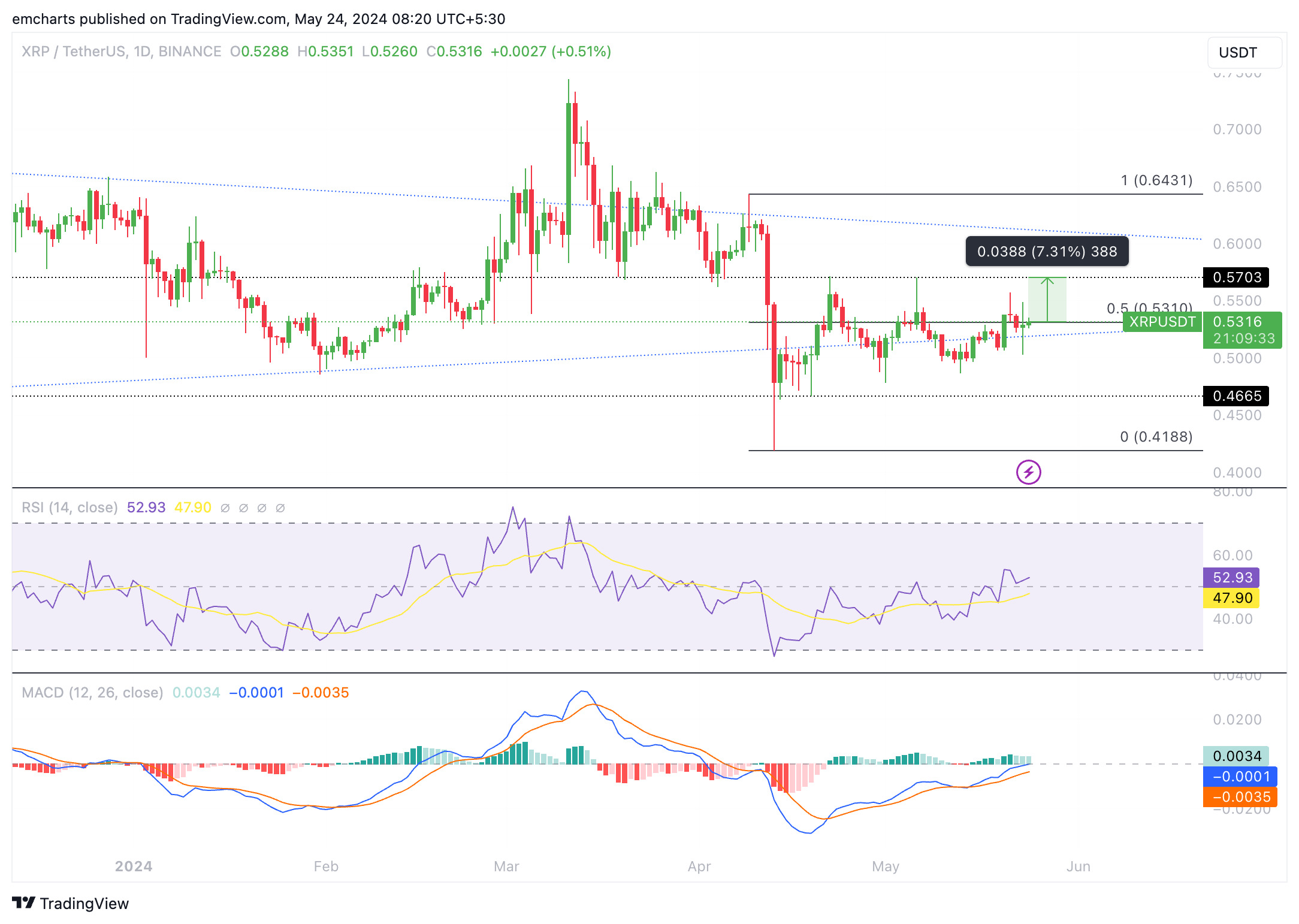XRP rallies past $0.53, SEC Chair Gensler says the regulator has done very well in court cases
- Ripple lawsuit ruling is expected soon, following the new US crypto bill, FIT21.
- SEC Chair Gary Gensler says the agency has fared well in legal battles while speaking at the ICI 2024 Leadership Summit.
- XRP rallied past $0.53 on Friday, adding 3% in value this week.
The ruling of the Ripple (XRP) lawsuit is pending, and holders await the court’s decision in the legal battle between the US Securities and Exchange Commission (SEC) and the payment remittance firm. Ripple’s Chief Executive Officer (CEO) Brad Garlinghouse and Chief Legal Officer (CLO) Stuart Alderoty have slammed SEC Chair Gary Gensler and his “regulation by enforcement” approach on more than one occasion.
Speaking at a leadership conference, Chair Gensler commented on the SEC’s performance in court cases.
XRP sustained its gains this week, rallying past $0.53 on Friday. The altcoin held on to a 5% increase in its value this week on Binance.
Daily Digest Market Movers: Ripple ruling awaited amidst FIT21 bill, Chair Gensler’s comments
- XRP holders await a court ruling in the SEC vs. Ripple lawsuit while agency Chair Gary Gensler comments on the agency’s performance in court cases.
- Chair Gensler spoke at the ICI 2024 Leadership Summit and said that the SEC has done very well in court on crypto cases.
- The blanket statement likely does not apply to the agency’s case against the payment remittance firm Ripple.
- In the SEC vs. Ripple lawsuit, the regulator alleged that the firm sold unregistered securities (XRP) to its institutional clients at different prices/ discounts therefore the firm netted “ill-gotten gains,” and demanded a fine of $2 billion be imposed on the firm.
- Ripple responded with a $10 million fine request, and according to attorneys familiar with the case, the firm is prepared for an injunction (ban) on the sale of XRP to institutional clients in the US.
- The SEC has noted wins in its ongoing lawsuits against Coinbase and exacted settlements/ fines from crypto exchanges Binance and Kraken in the past.
- The court’s ruling in the SEC vs. Ripple lawsuit is anticipated, and it remains to be seen whether the regulator will secure a victory in its legal battle.
- Pro-crypto attorneys and analysts in the XRP community speculate the impact of the newly approved FIT21 bill by one house of Congress.
- Ripple CEO Brad Garlinghouse voiced his opinion on FIT21 in a recent tweet on X:
Well, this certainly HAS aged well!
— Brad Garlinghouse (@bgarlinghouse) May 22, 2024
Today, more than ever, we are seeing what a political liability Gensler has been to the Biden administration.
It's the reason we saw 71 Dems cross the aisle and support FIT21.
We are just getting started! https://t.co/Ff6x78mgax
Technical analysis: XRP eyes over 7% gains as it extends rally
Ripple has been in an uptrend since April 13. The altcoin has formed higher highs and higher lows, as seen in the XRP/USDT 1-day chart. In its uptrend, the altcoin has preserved 3% gains from the week and surged past $0.53 on Friday.
The Moving Average Convergence Divergence (MACD), a momentum indicator, shows there is underlying positive momentum in the XRP uptrend. The Relative Strength Index (RSI) reads 52.93, supporting the recovery in XRP price.
If Ripple continues its uptrend, it could extend gains by over 7%, climbing to $0.5703, the high observed on May 6 and April 22. This level has acted as resistance for the altcoin since April 13.

XRP/USDT 1-day chart
On the downside, the XRP price could sweep liquidity at the May 23 low of $0.5027. This is a key level for the altcoin as it is close to $0.50, a psychologically important support for Ripple.
Bitcoin, altcoins, stablecoins FAQs
Bitcoin is the largest cryptocurrency by market capitalization, a virtual currency designed to serve as money. This form of payment cannot be controlled by any one person, group, or entity, which eliminates the need for third-party participation during financial transactions.
Altcoins are any cryptocurrency apart from Bitcoin, but some also regard Ethereum as a non-altcoin because it is from these two cryptocurrencies that forking happens. If this is true, then Litecoin is the first altcoin, forked from the Bitcoin protocol and, therefore, an “improved” version of it.
Stablecoins are cryptocurrencies designed to have a stable price, with their value backed by a reserve of the asset it represents. To achieve this, the value of any one stablecoin is pegged to a commodity or financial instrument, such as the US Dollar (USD), with its supply regulated by an algorithm or demand. The main goal of stablecoins is to provide an on/off-ramp for investors willing to trade and invest in cryptocurrencies. Stablecoins also allow investors to store value since cryptocurrencies, in general, are subject to volatility.
Bitcoin dominance is the ratio of Bitcoin's market capitalization to the total market capitalization of all cryptocurrencies combined. It provides a clear picture of Bitcoin’s interest among investors. A high BTC dominance typically happens before and during a bull run, in which investors resort to investing in relatively stable and high market capitalization cryptocurrency like Bitcoin. A drop in BTC dominance usually means that investors are moving their capital and/or profits to altcoins in a quest for higher returns, which usually triggers an explosion of altcoin rallies.

